MaryAnn Bernal's Blog, page 281
May 16, 2014
EbookSoda features The Briton and the Dane: Timeline
 The Briton and the Dane: Timelineby Mary Ann BernalCompelling time-travel romance adventureWill Gwyneth stop the assassins? Is she strong enough to walk away and watch her beloved Erik die? Or will she intervene, change the course of history and wipe out an entire timeline to save the man she loves with all her heart?Get it now$1.99 (£1.25) Amazon Kindle UK Amazon Kindle US
The Briton and the Dane: Timelineby Mary Ann BernalCompelling time-travel romance adventureWill Gwyneth stop the assassins? Is she strong enough to walk away and watch her beloved Erik die? Or will she intervene, change the course of history and wipe out an entire timeline to save the man she loves with all her heart?Get it now$1.99 (£1.25) Amazon Kindle UK Amazon Kindle US http://www.ebooksoda.com/ebook-deals/the-briton-and-the-dane-timeline-by-mary-ann-bernal

Published on May 16, 2014 05:39
Girl's skeleton found in cave sheds light on origins of first Americans
DNA recovered from 12,000-year-old skeleton helps to dispel claims that first Americans came from Australia, Asia or Europe
Ian Sample
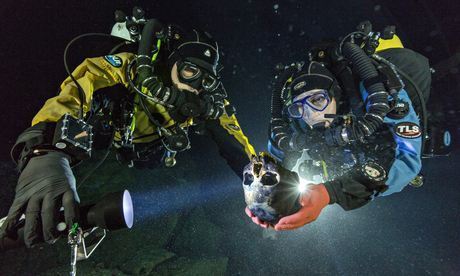
Divers Alberto Nava and Susan Bird with the girl's skull, which they found in a flooded cave system beneath the Yucatan jungle in Mexico. Photograph: Paul Nicklen/National Geographic The remains of a small, delicate teenage girl who fell to her death in an underground cave system in Mexico 12,000 years ago have thrown fresh light on the origins of the first Americans.
Cave divers chanced upon the girl's skeleton, along with the bones of sabre-tooth cats, giant ground sloths and cave bears, in a vast water-filled cavern they discovered while exploring a submerged network of tunnels reached from a sinkhole in the Yucatan jungle.
Researchers believe the girl, whom they have named Naia, died after breaking her pelvis when she fell into the cave, which would have been dry at the time, apart from a small, occasional pool at the bottom. Like the animals around her, she may have met her death after venturing into the cave system to look for drinking water.
The tunnels and bell-shaped cave, which is 60 metres across and 40 metres deep, filled with brackish water when melting glaciers caused the sea level to rise. The cavern is now well below sea level and can only be reached by technical divers.
Alberto Nava, a diver based in California, found the cavern and Naia's remains with two fellow divers in 2007. Deep inside the jungle, the trio had entered a crystal-clear pool that fed into the cave system. After swimming along a flooded tunnel for more than a kilometre, the cavern opened up before them.
"The moment we entered inside, we knew it was an incredible place. The floor disappeared under us and we could not see across to the other side. We plunged a way down inside. All we could see was darkness," Nava said. The divers named the cavern Hoyo Negra, which is Spanish for "black hole".
As the divers explored the cavern, they spotted a human skull perched on a ledge among some other bones. "It was a small cranium laying upside down with a perfect set of teeth and dark eye sockets looking back at us. The skull was resting on its humerus [an upper arm bone] and we could see the rest of the upper torso spread to the left and down on the ledge," Nava said.
The skeleton belonged to a slight young woman, aged 15 or 16 years old, who was only four feet 10 inches (1.47 metres) tall. To find out how long ago she lived, researchers carbon-dated her tooth enamel and used a separate technique to work out the age of tiny flower-like crystals that had grown on her bones when water rich in calcite dripped onto them from the cavern's damp limestone roof. Together, they put her remains at 12,000 to 13,000 years old.
The origins of the first Americans have been debated by scientists because some of the early skeletons from the region are unlike modern Native Americans. The older humans, known as palaeoamericans, had narrower skulls and other striking features that led some researchers to suggest they had different ancestral roots, perhaps in Australia, southeast Asia, or even Europe.
Modern Native Americans are almost certainly descendants of hunter-gatherers who lived in the ancient region of Beringia around the Bering Strait from 26,000 to 18,000 years ago. Those people crossed into North America and spread south after crossing the exposed Bering land bridge 17,000 years ago.
In a study published in Science on Thursday, a team led by Jim Chatters at Applied Paleoscience, a consultancy based in Bothell, Washington, provide rare genetic evidence that the very first Americans came from Beringian stock. They extracted genetic material from one of Naia's molars, specifically her mitochondrial DNA, which is passed exclusively down the maternal line. The DNA showed that Naia belonged to a lineage shared only with Native Americans.
"What this study is presenting for the first time is evidence that palaeoamericans, with those distinctive features, can also be directly tied to the same Beringian source population as contemporary Native Americans," said Deborah Bolnick, a co-author on the paper at the University of Texas, Austin.
So why do modern Native Americans look so different from the first Americans? Chatters told the journal that Native Americans, who have flatter, rounder faces, represented a more "domesticated" population that settled down as farmers in the Americas. There are other explanations, though. David Meltzer at Southern Methodist University in Dallas puts the differences down to "genetic drift", a random evolutionary process that gradually altered the appearance of Native Americans over thousands of years.
Tom Dillehay, an anthropologist at Vanderbilt University in Nashville, said that while the science was good, the interpretation was overstated. "It is simply one life story of one individual representing one possible interpretative scenario among many other possibilities," he told the Guardian. "It doesn't mean that all early skeletons from the Americas represent the same story."
http://www.theguardian.com/science/2014/may/15/girl-remains-cave-origins-first-americans-skeleton
Ian Sample

Divers Alberto Nava and Susan Bird with the girl's skull, which they found in a flooded cave system beneath the Yucatan jungle in Mexico. Photograph: Paul Nicklen/National Geographic The remains of a small, delicate teenage girl who fell to her death in an underground cave system in Mexico 12,000 years ago have thrown fresh light on the origins of the first Americans.
Cave divers chanced upon the girl's skeleton, along with the bones of sabre-tooth cats, giant ground sloths and cave bears, in a vast water-filled cavern they discovered while exploring a submerged network of tunnels reached from a sinkhole in the Yucatan jungle.
Researchers believe the girl, whom they have named Naia, died after breaking her pelvis when she fell into the cave, which would have been dry at the time, apart from a small, occasional pool at the bottom. Like the animals around her, she may have met her death after venturing into the cave system to look for drinking water.
The tunnels and bell-shaped cave, which is 60 metres across and 40 metres deep, filled with brackish water when melting glaciers caused the sea level to rise. The cavern is now well below sea level and can only be reached by technical divers.
Alberto Nava, a diver based in California, found the cavern and Naia's remains with two fellow divers in 2007. Deep inside the jungle, the trio had entered a crystal-clear pool that fed into the cave system. After swimming along a flooded tunnel for more than a kilometre, the cavern opened up before them.
"The moment we entered inside, we knew it was an incredible place. The floor disappeared under us and we could not see across to the other side. We plunged a way down inside. All we could see was darkness," Nava said. The divers named the cavern Hoyo Negra, which is Spanish for "black hole".
As the divers explored the cavern, they spotted a human skull perched on a ledge among some other bones. "It was a small cranium laying upside down with a perfect set of teeth and dark eye sockets looking back at us. The skull was resting on its humerus [an upper arm bone] and we could see the rest of the upper torso spread to the left and down on the ledge," Nava said.
The skeleton belonged to a slight young woman, aged 15 or 16 years old, who was only four feet 10 inches (1.47 metres) tall. To find out how long ago she lived, researchers carbon-dated her tooth enamel and used a separate technique to work out the age of tiny flower-like crystals that had grown on her bones when water rich in calcite dripped onto them from the cavern's damp limestone roof. Together, they put her remains at 12,000 to 13,000 years old.
The origins of the first Americans have been debated by scientists because some of the early skeletons from the region are unlike modern Native Americans. The older humans, known as palaeoamericans, had narrower skulls and other striking features that led some researchers to suggest they had different ancestral roots, perhaps in Australia, southeast Asia, or even Europe.
Modern Native Americans are almost certainly descendants of hunter-gatherers who lived in the ancient region of Beringia around the Bering Strait from 26,000 to 18,000 years ago. Those people crossed into North America and spread south after crossing the exposed Bering land bridge 17,000 years ago.
In a study published in Science on Thursday, a team led by Jim Chatters at Applied Paleoscience, a consultancy based in Bothell, Washington, provide rare genetic evidence that the very first Americans came from Beringian stock. They extracted genetic material from one of Naia's molars, specifically her mitochondrial DNA, which is passed exclusively down the maternal line. The DNA showed that Naia belonged to a lineage shared only with Native Americans.
"What this study is presenting for the first time is evidence that palaeoamericans, with those distinctive features, can also be directly tied to the same Beringian source population as contemporary Native Americans," said Deborah Bolnick, a co-author on the paper at the University of Texas, Austin.
So why do modern Native Americans look so different from the first Americans? Chatters told the journal that Native Americans, who have flatter, rounder faces, represented a more "domesticated" population that settled down as farmers in the Americas. There are other explanations, though. David Meltzer at Southern Methodist University in Dallas puts the differences down to "genetic drift", a random evolutionary process that gradually altered the appearance of Native Americans over thousands of years.
Tom Dillehay, an anthropologist at Vanderbilt University in Nashville, said that while the science was good, the interpretation was overstated. "It is simply one life story of one individual representing one possible interpretative scenario among many other possibilities," he told the Guardian. "It doesn't mean that all early skeletons from the Americas represent the same story."
http://www.theguardian.com/science/2014/may/15/girl-remains-cave-origins-first-americans-skeleton

Published on May 16, 2014 05:20
History Trivia - Mary, Queen of Scots, flees to England.
May 16
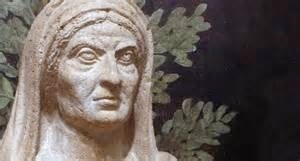
218 Julia Maesa, aunt of the assassinated Caracalla, was banished to her home in Syria by the self-proclaimed emperor Macrinus and declared her 14-year old grandson Elagabalus, emperor of Rome.
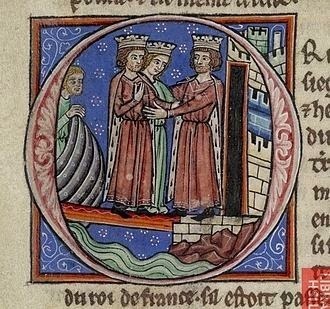
1152 Eleanor of Aquitaine married Henry Anjou.
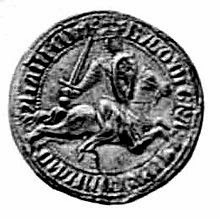
1204 Baldwin IX, Count of Flanders was crowned as the first Emperor of the Latin Empire.

1527 The Florentines drove out the Medici for a second time and Florence re-established itself as a republic.
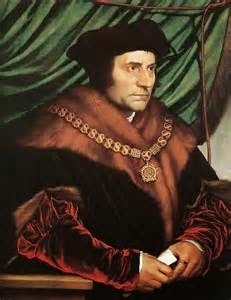
1532 Sir Thomas More resigned as Lord Chancellor of England.

1568 Mary, Queen of Scots, fled to England.


218 Julia Maesa, aunt of the assassinated Caracalla, was banished to her home in Syria by the self-proclaimed emperor Macrinus and declared her 14-year old grandson Elagabalus, emperor of Rome.

1152 Eleanor of Aquitaine married Henry Anjou.

1204 Baldwin IX, Count of Flanders was crowned as the first Emperor of the Latin Empire.

1527 The Florentines drove out the Medici for a second time and Florence re-established itself as a republic.

1532 Sir Thomas More resigned as Lord Chancellor of England.

1568 Mary, Queen of Scots, fled to England.

Published on May 16, 2014 05:16
May 15, 2014
Forget Folk Remedies, Medieval Europe Spawned A Golden Age of Medical Theory
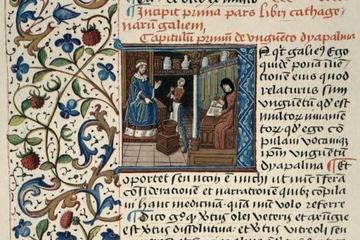
 Does your bad humour ail thee?
Does your bad humour ail thee?Credit: Wellcome Library Collection
View full size image
This article was originally published at The Conversation. The publication contributed the article to Live Science's Expert Voices: Op-Ed & Insights.
It’s often said that there was no tradition of scientific medicine in medieval times. According to the usual narrative of the history of progress, medicine in the European Middle Ages – from around the 5th to the 15th centuries – was a formless mass of superstition and folk remedies; the very antithesis of science.
And those who look in medieval medicine for precursors of modern pathology, surgery, antibiotics, or genetics will of course find it a failure. But if we’re looking for a coherent medical system that was intellectually and emotionally satisfying to its practitioners and patients, and based on written authorities, rational enquiry, and formal teaching, then medieval Europe produced one of the most influential and scientific medical systems in history.
Medieval medicine did take many forms. Some of it was non-literate and based on inherited traditions, some on the use of simple herbs, while other remedies were based on blaming elves or demons or sin for sickness. Sometimes it was practised by women for their families and servants.
But if we are careful with our definition of “science”, and use it to mean not (as often happens) what we now think is correct but rather a rationally organised body of knowledge about the natural world, then medieval medicine did use scientific methods.
And it was in the 11th century that Europe witnessed a medical revolution. Scholars and physicians in southern Italy, especially in the city of Salerno, began to study and teach ancient medical texts after a hiatus of 500 years or more. We know this from surviving 11th and 12th-century manuscripts that are only now being collectively studied, especially those of a little known medical textbook called the Articella.
The ArticellaHow we view medieval medicine, at the expense of alternate forms, is partly due to the nature of the surviving evidence we have. Apart from rare archaeological finds, this comes mostly from manuscripts primarily from the second half of the Middle Ages (c.1000-1500AD). Many of these manuscripts are copies of medical texts written much earlier, between about 400BC-1000AD. Some of these were in Latin, and had long sat ignored in monastic libraries. Others were in Arabic or Greek and were traded or carried across the Mediterranean to be translated into Latin.
These texts didn’t just appear; they were actively sought, translated and edited by newly curious medical teachers and practitioners. And they are how we know about a revolution in 11th-century European medicine.
By about 1100AD, an international body of philosophers and physicians, stretching north from Salerno to England, and east from Iberia to the German empire, had organised five Latin texts into a textbook called Ars Medicinae (“The Art of Medicine)” and later nicknamed the Articella (“The Little Art”). The five texts were the Isagoge (or “Introduction”) of Johanittius (an Arab Christian), the Aphorisms and Prognostics of Hippocrates, On Urines by Theophilus, and On Pulses by Philaretus. After about 1150, many copies of the Articella also include Galen’s Tegni (or Ars medica).
This may seem an overwhelming syllabus, but the entire Articella is shorter than any modern medical textbook. Each text served a different function in the classroom. The Isagoge was a brief introduction to medical theory. And through Hippocrates' Aphorisms and Prognostics, students learned brief and useful statements on medical practice by this father of medicine. The Byzantine Greek texts by Theophilus and Philaretus were the most practical, giving instructions for making diagnoses and prognoses with a patient’s urine and pulse. The Tegni encompassed and surpassed the first five texts, and so served as the basis of university exams and commentaries for centuries to come.
By 1200 the Articella was accepted throughout Europe as the foundation of medical education. Medieval university faculties of medicine made the Articella required reading along with the Canon of Medicine by Avicenna, first translated into Latin in the 1170s.
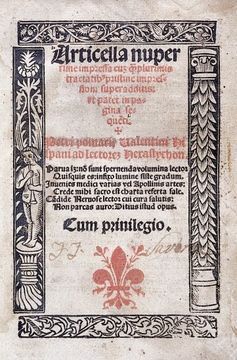
[image error]
 Articella, still going in 1534.
Articella, still going in 1534.Credit: Wellcome Images, CC BY-NC
View full size imageAnd after the invention of printing, the book appeared in at least 16 editions to 1534, surviving well beyond the usual dates for the Middle Ages.
It’s obvious that the Articella was popular, but why does it matter so much? The vast number of healers, men and women, had never read it. But the widespread acceptance of the Articella set the bar for medicine across Europe.
Every doctor, especially itinerant male healers in search of a wide clientele, had to know (or at least pretend to know) the rational medicine taught in the schools.
Knowledge of this distinctly medieval medicine, which was built on Greek and Arabic foundations but developed by generations of medical teachers and students into something new, was expected of any proper physician. Even those not directly involved in medicine, such as philosophers, lawyers, and theologians, began to incorporate learned medicine into their writings.
Corruption of the humoursBy the 12th century and up to the 16th, the majority of people in the noble, mercantile, and clerical classes of European cities agreed on a specific form of medical learning, generally known as scholastic medicine. Ideally, this medicine was practised only by Christian men and written in Latin. It was a highly literate science that was taught in the universities, and was based on the writings of ancient Greek and medieval Arabic physicians, especially Hippocrates (5th century BC), Galen (c.130-200AD), and Avicenna (the Latinised name of Ibn Sina, 980-1037AD) – one of the foremost thinkers in the Islamic world.
These authors and their medieval Latin followers created a medicine that was thoroughly holistic: sickness was explained by the imbalance or corruption of the four humours (blood, phlegm, yellow bile, black bile), the four principal liquids of the body. And health was achieved by the balance and proper cultivation of the humours. Each was necessary to human nature, but each could also grow too abundant or corrupted.
Physicians used these humours to explain every complaint – medical or psychological. The dominant pattern or mixture of humours determined a person’s complexion, a term referring not to the skin but to one’s entire bodily and mental constitution. And everyone’s complexion was slightly different, especially between the sexes, and also changed as one aged.
A physician’s course of treatment had to be tailored to the individual patient, or at least to their age group and gender. Diagnosis and prognosis took into consideration the whole person – using a system developed by Arab physicians out of Galen’s writings and called the “six non-naturals” – by which the physician ideally examined his patient’s food and drink, air and environment, sleep and wakefulness, motion and rest, evacuation and repletion, and emotions.
So before undertaking treatment, a physician trained in Galenic medicine took into consideration a wide range of factors, including complexion, environmental and personal “non-naturals”, and symptoms of the disease.
By the end of the Middle Ages, an educated physician might also look to the stars and cast horoscopes of his patient to determine prognosis and course of action. And treatments were generally conservative, tending toward advice on diet, exercise or bathing. When medicines were prescribed they were based on local herbs and alcohol for the average client or exotic spices and sugar for the wealthy – the former available from any village herbalist and the latter from apothecaries in urban areas.
Placebo actionMost of the regimens and prescriptions in surviving manuscripts would not have cured any condition, apart from improving the patient’s mood, but neither would they have done any harm. If their condition improved, credit could be given to the physician. If their did not improve, blame could be applied to anyone from the patient, the spouse, or children, or servants, the physician, or even the apothecary.
Therein lies part of the durability of medieval medicine: it offered a satisfactory explanatory system for disease in the absence of anything better, and the physician was not expected to work wonders, since he bore only part of the responsibility for treatment and cure.
The science of medieval medicine was centuries in the making: Arab physicians and teachers of the 10th to the 12th centuries, and Latin ones after the 11th worked and reworked the complicated inheritance of ancient medicine into a convenient, flexible, and rational system.
Despite its failure (by modern standards) to identify or cure most diseases, the medieval medicine of the Articella satisfied patients and practitioners for half a millennium, surviving even the Black Death and the Renaissance, to last well into the early modern era.
Winston Black does not work for, consult to, own shares in or receive funding from any company or organisation that would benefit from this article, and has no relevant affiliations.
This article was originally published on The Conversation. Read the original article. Follow all of the Expert Voices issues and debates — and become part of the discussion — on Facebook, Twitter and Google +. The views expressed are those of the author and do not necessarily reflect the views of the publisher. This version of the article was originally published on Live Science.
http://www.livescience.com/45623-forget-folk-remedies-medieval-europe-spawned-a-golden-age-of-medical-theory.html

Published on May 15, 2014 10:51
JLB Creatives Publishing at Scott's Zellwood Sweet Corn Jamboree May 17-18 10a-5p Mt. Dora, FL

JLB Creatives Publishing at Scott's Zellwood Sweet Corn Jamboree May 17-18 10a-5p Mt. Dora, FL
"Scott's Zellwood Sweet Corn Jamboree"
When: Saturday & Sunday, May 17th & 18th, 2014
Where: 26216 County Road 448A, Mt. Dora, Florida 32757

TICKETS ARE LIMITED!!!$1 parking donationAdult Admission at Gate $12.00***IF you purchase tickets in advance Adult tickets are only $10 Advanced tickets can be purchased below on-line OR at The First National Bank Of Mt. Dora, on Donnelly Street, at B&W Feed Store, on SR 441 in Tangerine OR at Mosquito Creek in Apopka, on SR 441 OR at Scott's Country Market.
Children Admission (5-12) $8.00
(age 4 & under free) Tickets include;
Live local entertainment, featuring the band 'Showdown' the previous house band for Sullivans/Cowboys. -
Other local entertainment -
Craft and Food vendors -
Two fresh, hot ears of our famous Scott's Zellwood Sweet Corn -
Access to Scott's Maze Adventure Playground
RAIN or SHINE no refunds
BRING A LAWN CHAIR AND/OR BLANKET. DRESS FOR THE WEATHER! **For all Farm Events:
All youth 16 and under must be accompanied by an adult
No coolers or outside alcohol
No animals
Smoking is only allowed in designated areas
Remember it is a Farm, you will be outdoors, come prepared for the elements
Some Outside Vendors only take cash (i.e. food vendors, face painters, crafters) http://longandscottfarms.com/maze_admissions_events.html

Published on May 15, 2014 09:55
History Trivia - Anna Boleyn and Lord Rochford tried on the charges of adultery/incest
May 15
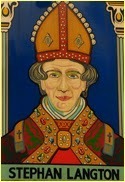
1213 King John named Stephen Langton Archbishop of Canterbury after submitting to the Pope's authority and offering to make England and Ireland papal fiefs, which resulted in Pope Innocent III lifting the interdict of 1208.

1252 Pope Innocent IV issued the papal bull ad exstirpanda, which authorized, but also limited, the torture of heretics in the Medieval Inquisition.
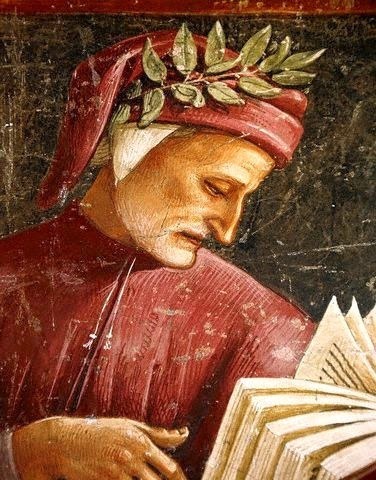
1265 Dante Alighieri, author of the Divine Comedy, was born.
 The Other Boleyn Girl
The Other Boleyn Girl
1536 Anna Boleyn and Lord Rochford stood trial on the charges of adultery/incest.
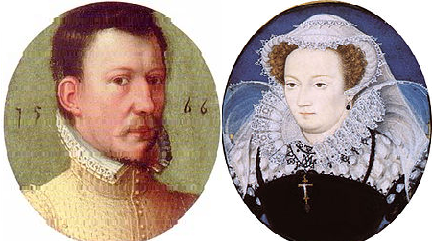 1567 Mary, Queen of Scots, married James Hepburn, 4th Earl of Bothwell, her third husband.
1567 Mary, Queen of Scots, married James Hepburn, 4th Earl of Bothwell, her third husband.
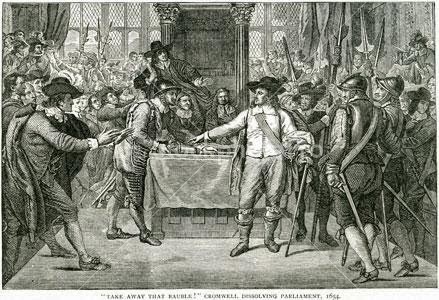
1649 The 'Rump Parliament' under Oliver Cromwell declared England a 'commonwealth' or free state.


1213 King John named Stephen Langton Archbishop of Canterbury after submitting to the Pope's authority and offering to make England and Ireland papal fiefs, which resulted in Pope Innocent III lifting the interdict of 1208.

1252 Pope Innocent IV issued the papal bull ad exstirpanda, which authorized, but also limited, the torture of heretics in the Medieval Inquisition.

1265 Dante Alighieri, author of the Divine Comedy, was born.
 The Other Boleyn Girl
The Other Boleyn Girl1536 Anna Boleyn and Lord Rochford stood trial on the charges of adultery/incest.
 1567 Mary, Queen of Scots, married James Hepburn, 4th Earl of Bothwell, her third husband.
1567 Mary, Queen of Scots, married James Hepburn, 4th Earl of Bothwell, her third husband. 
1649 The 'Rump Parliament' under Oliver Cromwell declared England a 'commonwealth' or free state.

Published on May 15, 2014 07:02
May 14, 2014
Burst Water Pipe Reveals Century-Old Crusader Murals in Jerusalem
By Stephanie Pappas, Senior Writer
 Rediscovered late-1800s paintings in a storeroom in Saint-Louis Hospice, a Jerusalem hospital built by a prominant Christian.
Rediscovered late-1800s paintings in a storeroom in Saint-Louis Hospice, a Jerusalem hospital built by a prominant Christian.
Credit: Israel Antiquities Authority
Wall murals portraying Crusader knights and symbols of medieval military orders have been rediscovered in a Jerusalem hospital thanks to a burst water pipe and a storeroom reorganization.
These paintings were the works of a French count, Comte Marie Paul Amédée de Piellat, who believed himself to be a descendant of Crusaders. The count was a frequent visitor to Jerusalem and had the Saint-Louis Hospice built between 1879 and 1896, naming it after St. Louis IX, a king of France and leader of the Seventh Crusade between A.D. 1248 and 1254.
During World War I, however, the hospital came under the control of Turkish forces, who painted over the designs with black paint. The count returned to Jerusalem to restore his murals, but died in the hospital in 1925, his work undone. [See Images of the Rediscovered Murals]
A beautiful discovery
More recently, the nuns who run the hospital found some of the forgotten wall paintings while reorganizing storerooms in the building, according to the Israel Antiquities Authority (IAA). A burst water pipe also stripped away modern paint and plaster, revealing more sections of the paintings.
IAA conservators are now working to clean and stabilize the paintings, and are looking for funds to continue the preservation work. There are no plans to turn the paintings into a tourist attraction, however, as the hospital is still in use for chronic and terminally ill patients. Sisters of the order of St. Joseph of the Apparition run the facility.
De Piellat was a devout Christian who wanted to boost the Catholic presence in Jerusalem at a time when multiple religious factions vied for influence in the city. His two-story hospital replaced a smaller medical facility in the city's Christian Quarter. For Saint-Louis, de Piellat chose a location where the Norman king Tancred and his forces camped before storming Jerusalem in A.D. 1099, during the First Crusade. Today, the hospital is next to the Jerusalem municipal building and IDF square, which is on the dividing line between Israeli-dominated West Jerusalem and heavily Palestinian East Jerusalem.
Artistic history
The murals themselves are enormous paintings of Crusader knights dressed in full battle gear. The count also painted the names and genealogy of the families of French Crusaders, including their heraldry symbols. The murals are further decorated with symbols of military and monastic orders and cities conquered in the Crusades.
At the time de Piellat was working, the city was under the control of the Ottoman Turks. During the upheaval of World War I, the Turks took control of the building, according to the IAA, and painted over the Christian murals. The British captured Jerusalem from the Turks in 1917, at the end of the war.
De Piellat returned to his beloved hospital after the war and worked to restore his murals. After his death in 1925, however, no one took up his fallen paintbrush, and the unrestored murals were mostly forgotten.
http://www.livescience.com/45603-jerusalem-hospital-muruals.html
 Rediscovered late-1800s paintings in a storeroom in Saint-Louis Hospice, a Jerusalem hospital built by a prominant Christian.
Rediscovered late-1800s paintings in a storeroom in Saint-Louis Hospice, a Jerusalem hospital built by a prominant Christian.Credit: Israel Antiquities Authority
Wall murals portraying Crusader knights and symbols of medieval military orders have been rediscovered in a Jerusalem hospital thanks to a burst water pipe and a storeroom reorganization.
These paintings were the works of a French count, Comte Marie Paul Amédée de Piellat, who believed himself to be a descendant of Crusaders. The count was a frequent visitor to Jerusalem and had the Saint-Louis Hospice built between 1879 and 1896, naming it after St. Louis IX, a king of France and leader of the Seventh Crusade between A.D. 1248 and 1254.
During World War I, however, the hospital came under the control of Turkish forces, who painted over the designs with black paint. The count returned to Jerusalem to restore his murals, but died in the hospital in 1925, his work undone. [See Images of the Rediscovered Murals]
A beautiful discovery
More recently, the nuns who run the hospital found some of the forgotten wall paintings while reorganizing storerooms in the building, according to the Israel Antiquities Authority (IAA). A burst water pipe also stripped away modern paint and plaster, revealing more sections of the paintings.
IAA conservators are now working to clean and stabilize the paintings, and are looking for funds to continue the preservation work. There are no plans to turn the paintings into a tourist attraction, however, as the hospital is still in use for chronic and terminally ill patients. Sisters of the order of St. Joseph of the Apparition run the facility.
De Piellat was a devout Christian who wanted to boost the Catholic presence in Jerusalem at a time when multiple religious factions vied for influence in the city. His two-story hospital replaced a smaller medical facility in the city's Christian Quarter. For Saint-Louis, de Piellat chose a location where the Norman king Tancred and his forces camped before storming Jerusalem in A.D. 1099, during the First Crusade. Today, the hospital is next to the Jerusalem municipal building and IDF square, which is on the dividing line between Israeli-dominated West Jerusalem and heavily Palestinian East Jerusalem.
Artistic history
The murals themselves are enormous paintings of Crusader knights dressed in full battle gear. The count also painted the names and genealogy of the families of French Crusaders, including their heraldry symbols. The murals are further decorated with symbols of military and monastic orders and cities conquered in the Crusades.
At the time de Piellat was working, the city was under the control of the Ottoman Turks. During the upheaval of World War I, the Turks took control of the building, according to the IAA, and painted over the Christian murals. The British captured Jerusalem from the Turks in 1917, at the end of the war.
De Piellat returned to his beloved hospital after the war and worked to restore his murals. After his death in 1925, however, no one took up his fallen paintbrush, and the unrestored murals were mostly forgotten.
http://www.livescience.com/45603-jerusalem-hospital-muruals.html

Published on May 14, 2014 14:05
Mummified fetus found in tiny ancient Egyptian sarcophagus
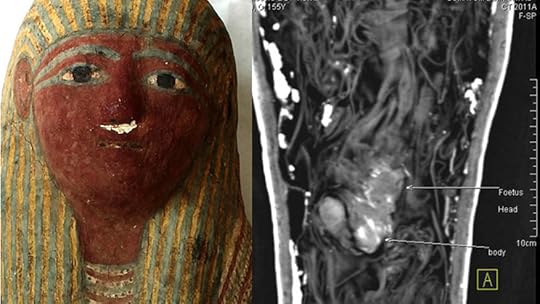 The mummy mask and the CT scan showing the fetus.Carolyn Graves-Brown/Swansea Universityâs Egypt Center By Rossella Lorenzi A suspected fake mummy currently on display at an Egypt center in Wales, in fact contains a fetus 12 to 16 weeks into development, CT scan has revealed.
The mummy mask and the CT scan showing the fetus.Carolyn Graves-Brown/Swansea Universityâs Egypt Center By Rossella Lorenzi A suspected fake mummy currently on display at an Egypt center in Wales, in fact contains a fetus 12 to 16 weeks into development, CT scan has revealed.Known as W1013, the 20-inch artifact is a case made of cartonnage — layers of linen stiffened with plaster or glue — and belongs to the Wellcome collection at Swansea University’s Egypt Center, which houses more than 5,000 objects. Most of them were collected by the Victorian pharmaceutical entrepreneur and archaeologist Sir Henry Wellcome on excavations in Egypt.
ADVERTISEMENTADVERTISEMENTThe tiny mummy came to Swansea in 1971, but nothing is known about where Wellcome obtained it.
Video: Why Did We Stop Building Pyramids?
The mummy has long puzzled experts. It is colorfully decorated in a style dating back to the 26th Dynasty, around 600 B.C.
The inconclusive results of an X-ray carried out in 1998 combined with meaningless inscriptions painted on the cartonnage case, suggested the mummy could have been a 19th century forgery.
“But it’s not unusual for sham hieroglyphs to be placed on coffins. Undoubtedly this would indicate that the maker of the piece was not literate,” curator Carolyn Graves-Brown told Discovery News.
Further research solved the mystery.
Photos: Mystery Pharaoh Found in Egypt
Last month, Swansea University’s Paola Griffiths of the Clinical Imaging College of Medicine, CT scanned the artifact.
It was then revealed the majority of the interior of the case is taken up by what appears to be linen bandages.
Within those folded strips of material, the CT scan showed a darker area about 3 inches long which researchers identified as a fetus in fetal position and with a placental sac. What could be the fetus’s femur was also identified.
“The length of the femur together with the size of the dark patch is consistent with that of a 12 to 16-week-old fetus,” Graves-Brown said.
Photos: Mummy Stash Found in Italian Church
“Another dark patch suggests the presence of an amulet and there are several areas with dark circles resembling strings of beads or tassels,” she added.
Decorated with criss-cross pattern of rhombus shapes perhaps imitating the bead net placed over some other mummies, the cartonnage case might provide some clues on the unborn baby’s sex.
The face is painted in reddish-brown, a color usually associated with men. Moreover, the heavy, yellow and blue striped wig and wide collar are most common on male coffins.
But Graves-Brown cautions: “As the fetus is only 12-16 weeks and is not in a perfect state of preservation I would not guess the sex,” he said.
2,400-Year-Old Myths of Mummy-Making Busted
The finding revealed the care with which even the fetus was treated in ancient Egypt.
“For example, two coffins holding fetuses were found in the tomb of Tutankhamun. In New Kingdom (around 1550-1070 B.C.) Deir el-Medina, a part of the Eastern cemetery seems to have been set aside for child burials, but also fetuses and even placentas in bloody cloths,” Graves-Brown said.
The fact that fetuses and infants were buried with such care indicate that deaths of young children as well as miscarriages were not treated casually.
“We can imagine that the probable fetus within W1013 represents someone’s terrible loss; an occasion of great grief and public mourning,” Graves-Brown said.
http://www.foxnews.com/science/2014/05/13/mummified-fetus-found-in-tiny-ancient-egyptian-sarcophagus/

Published on May 14, 2014 13:59
Santa Maria! Five more shipwrecks that came back from the deep
Marine archaeologists think they have located the remains of Christopher Columbus's flagship, the Santa Maria, off the coast of Haiti. It joins an impressive list of other historic wrecks that have been found recently
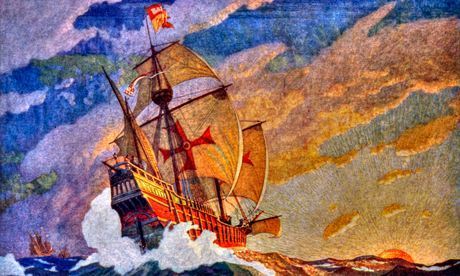 Christopher Columbus's flagship, the Santa Maria, and his other two ships in a dramatic artist's impression. Photograph: Alamy Queen Anne's Revenge Perhaps the most famous of all pirate ships began life in 1710 as a Royal Navy frigate called the Concord. Almost immediately after launch, she was captured by the French and converted into a slave ship, before being captured again by the pirate Ben Hornigold near Martinique. Hornigold put her under the command of one of his men, Edward Teach, soon to be known as Blackbeard. Just one busy year later, Blackbeard ran the ship aground off the coast of North Carolina, where it remained undisturbed until being rediscovered by the private research firm Intersal in 1996. Since then, many items have been salvaged, including a motley assortment of cannons, and the 1.4-tonne anchor.
Christopher Columbus's flagship, the Santa Maria, and his other two ships in a dramatic artist's impression. Photograph: Alamy Queen Anne's Revenge Perhaps the most famous of all pirate ships began life in 1710 as a Royal Navy frigate called the Concord. Almost immediately after launch, she was captured by the French and converted into a slave ship, before being captured again by the pirate Ben Hornigold near Martinique. Hornigold put her under the command of one of his men, Edward Teach, soon to be known as Blackbeard. Just one busy year later, Blackbeard ran the ship aground off the coast of North Carolina, where it remained undisturbed until being rediscovered by the private research firm Intersal in 1996. Since then, many items have been salvaged, including a motley assortment of cannons, and the 1.4-tonne anchor.
Quedagh MerchantOriginally an Armenian-built Indian merchant vessel, this ship became famous when it was captured by Captain Kidd in 1698 near Kochi in the Arabian Sea. A privateer with instructions to loot enemy vessels, Kidd was subsequently considered a pirate, and hid the Quedagh Merchant before being captured and hung, after a sensational trial. For centuries, the ship's unknown location was a matter of legend, until it was at last found off Catalina Island in the Dominican Republic in 2007. Incredibly, it lay in shallow clear water close to the shore, and had never been touched.
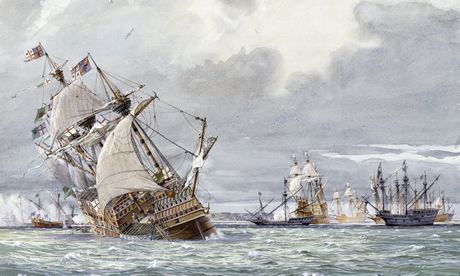 A reconstruction of the day the Mary Rose sank in the Solent in 1545. Photograph: Richard Schlecht/National Geographic/Getty Images The Mary RoseIt was never very far away – only in the Solent – but Henry VIII's beloved warship proved remarkably elusive after it sank in 1545, while leading an attack on the invading French fleet. A group of specialist salvors from Venice managed to reclaim some bits and pieces straight away, but soon afterwards it was forgotten. In 1836, the diving pioneers John and Charles Deane returned after a fishing net snagged on part of the wreckage, but they promptly lost the location again after recovering a few timbers and weapons. Finally, in 1971, the ship was found again, and then famously raised in 1982. It is now on display in Portsmouth.
A reconstruction of the day the Mary Rose sank in the Solent in 1545. Photograph: Richard Schlecht/National Geographic/Getty Images The Mary RoseIt was never very far away – only in the Solent – but Henry VIII's beloved warship proved remarkably elusive after it sank in 1545, while leading an attack on the invading French fleet. A group of specialist salvors from Venice managed to reclaim some bits and pieces straight away, but soon afterwards it was forgotten. In 1836, the diving pioneers John and Charles Deane returned after a fishing net snagged on part of the wreckage, but they promptly lost the location again after recovering a few timbers and weapons. Finally, in 1971, the ship was found again, and then famously raised in 1982. It is now on display in Portsmouth.
HMS BeagleIn itself, the ship that launched the theory of evolution was unremarkable. Built as a basic 10-gun Royal Navy brig in 1820, it was soon refitted as a survey vessel, in which state it carried Darwin on his momentous voyage to South America in 1831. Years later, it began to be used as a Customs and Excise patrol boat, catching smugglers off the Essex coast, and was last heard of being sold for scrap (for £525) in 1870. Yet recent research appears to have found most of it buried under 12ft of mud in the river Roach. If correct, the Beagle could, in theory, be excavated and one day put on show.
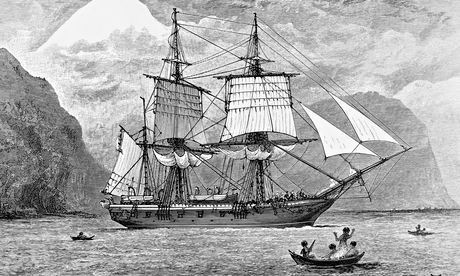 HMS Beagle Photograph: Bettmann/Corbis HMS VictoryNelson's flagship of the same name never sank, and today is in Portsmouth as a museum ship. Its predecessor, however, was one of the Royal Navy's greatest warships until it disappeared in a storm near the Channel Islands in 1744. In 2008, it was found by the underwater treasure-hunting company Odyssey Marine, which plans to raise the wreck in the near future. As their website says: "Research indicates that the Victory sank with a substantial amount of specie aboard." Specie means coins – specifically here gold and silver – which might today be worth as much as £500m.
HMS Beagle Photograph: Bettmann/Corbis HMS VictoryNelson's flagship of the same name never sank, and today is in Portsmouth as a museum ship. Its predecessor, however, was one of the Royal Navy's greatest warships until it disappeared in a storm near the Channel Islands in 1744. In 2008, it was found by the underwater treasure-hunting company Odyssey Marine, which plans to raise the wreck in the near future. As their website says: "Research indicates that the Victory sank with a substantial amount of specie aboard." Specie means coins – specifically here gold and silver – which might today be worth as much as £500m.
• This article was amended on 14 May 2014. The Mary Rose was raised in 1982, not 1980 as a previous version said.
http://www.theguardian.com/science/shortcuts/2014/may/13/five-great-shipwrecks-back-from-deep-santa-maria
 Christopher Columbus's flagship, the Santa Maria, and his other two ships in a dramatic artist's impression. Photograph: Alamy Queen Anne's Revenge Perhaps the most famous of all pirate ships began life in 1710 as a Royal Navy frigate called the Concord. Almost immediately after launch, she was captured by the French and converted into a slave ship, before being captured again by the pirate Ben Hornigold near Martinique. Hornigold put her under the command of one of his men, Edward Teach, soon to be known as Blackbeard. Just one busy year later, Blackbeard ran the ship aground off the coast of North Carolina, where it remained undisturbed until being rediscovered by the private research firm Intersal in 1996. Since then, many items have been salvaged, including a motley assortment of cannons, and the 1.4-tonne anchor.
Christopher Columbus's flagship, the Santa Maria, and his other two ships in a dramatic artist's impression. Photograph: Alamy Queen Anne's Revenge Perhaps the most famous of all pirate ships began life in 1710 as a Royal Navy frigate called the Concord. Almost immediately after launch, she was captured by the French and converted into a slave ship, before being captured again by the pirate Ben Hornigold near Martinique. Hornigold put her under the command of one of his men, Edward Teach, soon to be known as Blackbeard. Just one busy year later, Blackbeard ran the ship aground off the coast of North Carolina, where it remained undisturbed until being rediscovered by the private research firm Intersal in 1996. Since then, many items have been salvaged, including a motley assortment of cannons, and the 1.4-tonne anchor.Quedagh MerchantOriginally an Armenian-built Indian merchant vessel, this ship became famous when it was captured by Captain Kidd in 1698 near Kochi in the Arabian Sea. A privateer with instructions to loot enemy vessels, Kidd was subsequently considered a pirate, and hid the Quedagh Merchant before being captured and hung, after a sensational trial. For centuries, the ship's unknown location was a matter of legend, until it was at last found off Catalina Island in the Dominican Republic in 2007. Incredibly, it lay in shallow clear water close to the shore, and had never been touched.
 A reconstruction of the day the Mary Rose sank in the Solent in 1545. Photograph: Richard Schlecht/National Geographic/Getty Images The Mary RoseIt was never very far away – only in the Solent – but Henry VIII's beloved warship proved remarkably elusive after it sank in 1545, while leading an attack on the invading French fleet. A group of specialist salvors from Venice managed to reclaim some bits and pieces straight away, but soon afterwards it was forgotten. In 1836, the diving pioneers John and Charles Deane returned after a fishing net snagged on part of the wreckage, but they promptly lost the location again after recovering a few timbers and weapons. Finally, in 1971, the ship was found again, and then famously raised in 1982. It is now on display in Portsmouth.
A reconstruction of the day the Mary Rose sank in the Solent in 1545. Photograph: Richard Schlecht/National Geographic/Getty Images The Mary RoseIt was never very far away – only in the Solent – but Henry VIII's beloved warship proved remarkably elusive after it sank in 1545, while leading an attack on the invading French fleet. A group of specialist salvors from Venice managed to reclaim some bits and pieces straight away, but soon afterwards it was forgotten. In 1836, the diving pioneers John and Charles Deane returned after a fishing net snagged on part of the wreckage, but they promptly lost the location again after recovering a few timbers and weapons. Finally, in 1971, the ship was found again, and then famously raised in 1982. It is now on display in Portsmouth.HMS BeagleIn itself, the ship that launched the theory of evolution was unremarkable. Built as a basic 10-gun Royal Navy brig in 1820, it was soon refitted as a survey vessel, in which state it carried Darwin on his momentous voyage to South America in 1831. Years later, it began to be used as a Customs and Excise patrol boat, catching smugglers off the Essex coast, and was last heard of being sold for scrap (for £525) in 1870. Yet recent research appears to have found most of it buried under 12ft of mud in the river Roach. If correct, the Beagle could, in theory, be excavated and one day put on show.
 HMS Beagle Photograph: Bettmann/Corbis HMS VictoryNelson's flagship of the same name never sank, and today is in Portsmouth as a museum ship. Its predecessor, however, was one of the Royal Navy's greatest warships until it disappeared in a storm near the Channel Islands in 1744. In 2008, it was found by the underwater treasure-hunting company Odyssey Marine, which plans to raise the wreck in the near future. As their website says: "Research indicates that the Victory sank with a substantial amount of specie aboard." Specie means coins – specifically here gold and silver – which might today be worth as much as £500m.
HMS Beagle Photograph: Bettmann/Corbis HMS VictoryNelson's flagship of the same name never sank, and today is in Portsmouth as a museum ship. Its predecessor, however, was one of the Royal Navy's greatest warships until it disappeared in a storm near the Channel Islands in 1744. In 2008, it was found by the underwater treasure-hunting company Odyssey Marine, which plans to raise the wreck in the near future. As their website says: "Research indicates that the Victory sank with a substantial amount of specie aboard." Specie means coins – specifically here gold and silver – which might today be worth as much as £500m.• This article was amended on 14 May 2014. The Mary Rose was raised in 1982, not 1980 as a previous version said.
http://www.theguardian.com/science/shortcuts/2014/may/13/five-great-shipwrecks-back-from-deep-santa-maria

Published on May 14, 2014 13:51
LOST TREASURES OF THE ANCIENT WORLD (1998): 1. STONEHENGE AND THE ANCIENT BRITONS
Published on May 14, 2014 09:31




